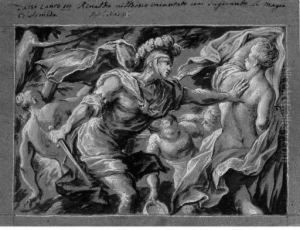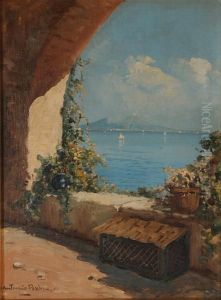Antonio Nasini Paintings
Antonio Nasini was an Italian painter of the Baroque period, born in 1657 in Montepulciano, Tuscany. He was a part of a family of artists, which included his brother Giuseppe Nicola Nasini and his son, Apollonio Nasini, both of whom were also painters. Antonio's training is believed to have started in the artistic environment of his family, but he significantly advanced his skills and style under the tutelage of the prominent Florentine painter, Ciro Ferri, who was a leading figure in the Baroque art movement in Italy and a key follower of Pietro da Cortona.
Nasini's work is characterized by its dynamic compositions, vivid colors, and dramatic use of light and shadow, typical of the Baroque style. He was particularly noted for his frescoes and ceiling paintings, which adorned many churches and palaces across Italy. His art was not confined to religious themes alone; Nasini also painted mythological scenes and portraits, displaying a versatility that was highly appreciated by his contemporaries.
Throughout his career, Antonio Nasini received numerous commissions from the Medici family, which played a pivotal role in his success and the dissemination of his work. His contributions to the artistic landscape of the time were significant, helping to perpetuate the Baroque tradition in Italy. Some of his notable works include frescoes in the Palazzo Pitti and the Basilica of San Lorenzo in Florence, which showcase his mastery over large-scale compositions and his ability to imbue his subjects with a sense of grace and vitality.
Nasini's influence extended beyond his immediate circle through his teaching; his work influenced a number of younger artists, including members of his own family. His legacy is a testament to the enduring appeal of Baroque art and its capacity to evoke emotion and awe through its expressive power and technical virtuosity. Antonio Nasini died in 1726, leaving behind a body of work that continues to be studied and admired for its artistic merit and historical significance.

